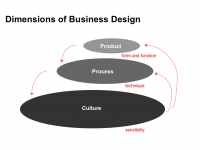Nicholas Carr’s argument against peer-production of knowledge by “amateurs” has been getting a lot of attention, but I think it misses the point.
It’s not human-centered. I don’t mean that in a make the interface easy to use kind of way, but in a make it something people want kind of way. For example:
- We’re still learning that worse is better. In many cases simplicity is more important than correctness, consistency, and completeness. This is the reason Unix won out over Lisp (and then Linux over Unix), and more people read Wikipedia than Encyclopedia Brittanica. Most of the time a fast and free resource will suffice. It’s what people want.
- The algorithm that creates MP3s can make files smaller because it reproduces only the sound that humans hear and discards the rest, instead of trying to keep all the sound the microphone hears. MP3s won out over audiophile options because people like having 10,000 songs in their pocket. Most of the time a fast and free resource will suffice. It’s what people want.
Besides, these products don’t stay “worse” forever. They start simple, gain “market share” in a disruptive way, and then are improved over time. Linux has improved considerably. Wikipedia gets better every minute. AAC is an improvement over MP3. The new breed of wikis look swanky compared to the original wikis.
The ability to launch something simple and improve it over time is a huge competitive advantage for companies like Google. Can you imagine an established company having the discipline to launch something as simple as Craigslist?
The mantra is Do The Simplest Thing That Could Possibly Work.
 Bruce Nussbaum (on his new blog, congratulations Bruce!)
Bruce Nussbaum (on his new blog, congratulations Bruce!) 


